 Facebook
Facebook
 X
X
 Instagram
Instagram
 TikTok
TikTok
 Youtube
Youtube
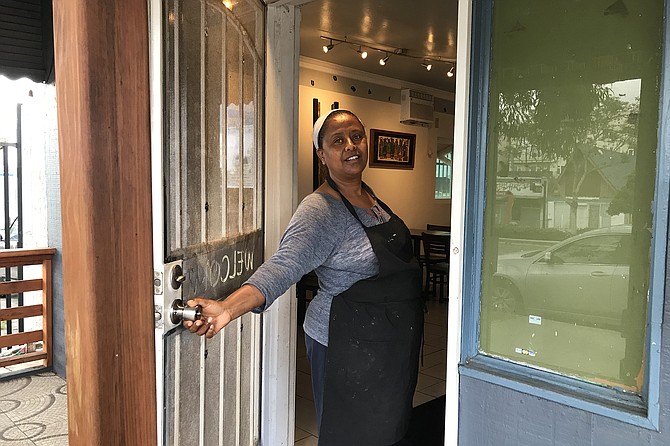
So last week, when the governor said “Restaurants can open,” did he mean like straightaway?
“Let’s go see,” I say to my Scottish friend Annie.
“Och,” she says. “Yer bum’s oot the windae!” Translation: You’re talking nonsense. “It’ll take weeks.”
Still, half an hour later we’re cruising in her car under the “The Boulevard” sign on ECB, craning our necks for signs of restaurant life.
“Over there!” I say. “Turn left at Arizona.”
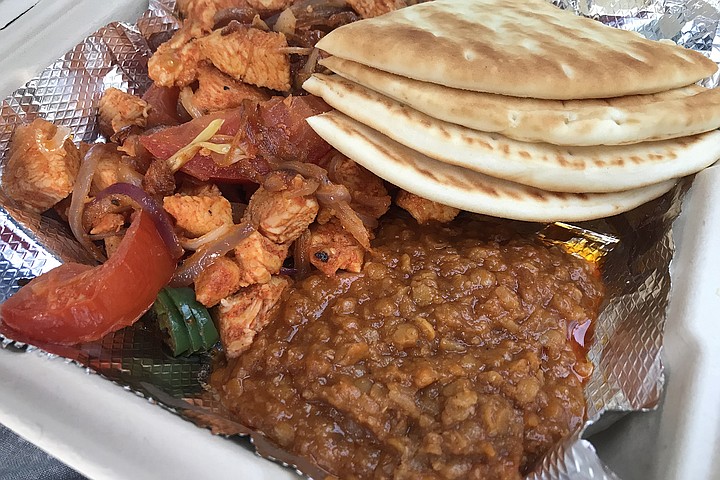
She does, and we haul up in front of this li’l ol’ wooden bungalow-storefront. “Gihon,” it says. Strings of lights. “Open” sign in the window. Place looks like it’s just been through a refresher course. Gray on gray with fresh redwood railings on the porch, and a white metal security door with “Welcome” across the front.
Except it’s locked.
But lights are on inside, and through a small mesh vent to the right, I can hear pans clacking and smell umami scents wafting out. “One moment, please,” says a woman’s voice. “Cooking. There’s just me.”
So I stand on the porch for a while, listening to the sounds of cooking, delighting in the smells of onions, garlic, ginger —and is it fenugreek causing that sweetish, maple-syrupy overtone to waft out?
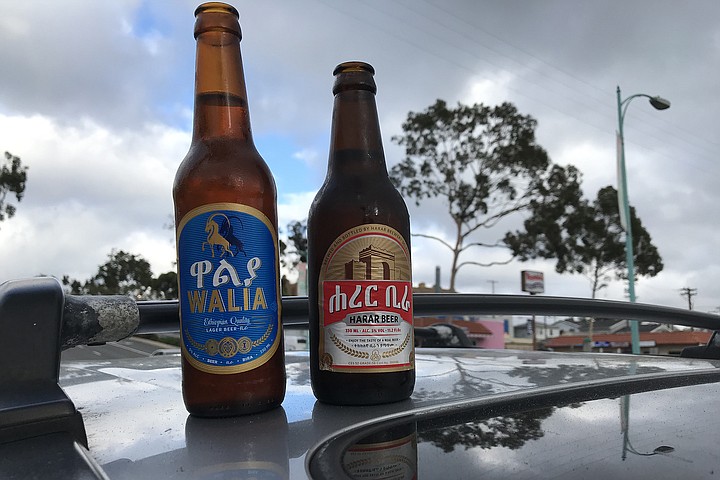
This is when I notice a menu in the Gihon’s front window.
They have starters like lentil hummus with injera crisps ($6), aukri (soybean) dip, $6, and sambusas stuffed with chicken or lentils ($3.50 each). I notice there’s a big play for vegan. The main section of the menu seems to be taken up with vegan dishes. All except one cost $11. The gomen (collard greens sautéed with onions, garlic and spices); the misir (red lentils) with berbere sauce (including Chile peppers, coriander, garlic, ginger); kay sir (red beets and potatoes); or eggplant wot (stew) in a berbere sauce, which sounds interesting.
But the main, the signature dish, is tibs: cubed meat, sautéed in spices. These cost between $14 and $18, depending on the meats (chicken, lamb, salmon, ribeye,or filet mignon). For that, you also get one of the vegan sides, and a choice of injera, pita bread, or rice.
Injera’s a bread, but not like our bread. For starters a main ingredient is Ethiopian teff, a kind of grain that’s gluten-free and twice as healthy as wheat, from what I hear.
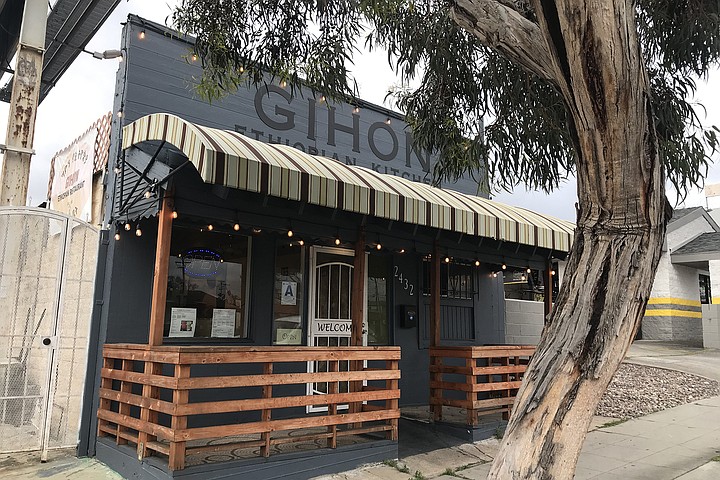
The lady owner-chef appears, Mesk G. “But people call me ‘Mercy.’”
“So I see most of your food is vegan,” I say.
“It’s an important part of the Ethiopian diet,” Mercy says. This place used to serve the opposite. “It used to be Granger’s Burgers, from the 1940s through the nineties.”
Why does she call it “Gihon”?
“The Gihon is one of our rivers. It’s in the Book of Genesis. One of the four rivers that flow from the Garden of Eden, with the Pishon, the Tigris, the Euphrates.”
Annie barps her horn and looks at me like “WTF?”
Oh, right. Annie is a carnivore, so for her I choose the tibs. I name the $14 chicken version with a side of misir in berbere sauce, and pita bread for her. And for me? I go vegan with eggplant wot ($11). But I also ask for four sambusas — chicken and lentil — $3.50 each, a lentil hummus ($6), and what the heck, two different bottles of Ethiopian beer, Walia and Harar ($5 each). We’re splitting. So that’s $25 each. But I know we’ll both be taking a lot home.
The nice thing is, while we’re still waiting for the main dishes, Mercy brings the hummus out to the car. So for the 15 minutes it takes to cook our main meal, we crack away at the chips and I guzzle the beers. Have to say, I prefer the Walia, but they’re both good.
“Where are we going to eat all this!” says Annie, when Mercy brings out the rest.
Then I have this idea. “Head down ECB, turn right on Park, to Adams Avenue, turn right.”
“Why?”
“There’s a cute park there.”
Five minutes later, here we are, at Trolley Barn Park, just as light’s fading. It’s a perfect place. It’s little, and runs right to a grassy cliff looking out over Mission Valley. People are sprawled out everywhere on the grass, under the trees, talking, snacking, playing ball with their dogs and kids. Annie has a blanket in the back. We spread it out, and start undoing the boxes.
For starters, I love the baked injera chips that Mercy left for us to use as scoops for the green lentil hummus.
“I just saw a red-tailed hawk flying by, at eye level!” says this gal who’s having her evening meal picnic-style with her friend, like dozens of others.
We each unwrap our box. Annie’s has the red lentils, salad, and chunks of marinated chicken. I take one. Aah, the chicken. Has salty-citrusy spicy-hot flavors of berbere, as well as onions, jalapeño, herbs.
But mine is almost as good. The eggplant looks wicked. It sits like a caldera in the folding wads of injera, which actually looks like some kind of carpet underlay. But you grab a fold, rip it off, then use it to pick up some of the black and brown magma. The roasted eggplant swims with flicky onions and garlic. Totally dee-lish. And the injera adds a beer flavor from its own 3-day fermentation.
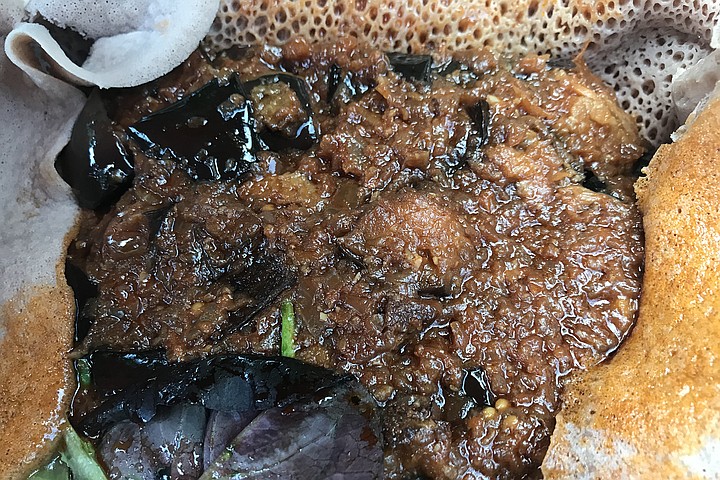
We sit here, just grooving on the whole scene. “Really,” I say, “with places like this, who needs restaurants?”
The answer comes two minutes later when the clouds start sending down a fine mist of the wet stuff.
“Once again,” says Annie, “Yer bum’s oot the windae.”


So last week, when the governor said “Restaurants can open,” did he mean like straightaway?
“Let’s go see,” I say to my Scottish friend Annie.
“Och,” she says. “Yer bum’s oot the windae!” Translation: You’re talking nonsense. “It’ll take weeks.”
Still, half an hour later we’re cruising in her car under the “The Boulevard” sign on ECB, craning our necks for signs of restaurant life.
“Over there!” I say. “Turn left at Arizona.”

She does, and we haul up in front of this li’l ol’ wooden bungalow-storefront. “Gihon,” it says. Strings of lights. “Open” sign in the window. Place looks like it’s just been through a refresher course. Gray on gray with fresh redwood railings on the porch, and a white metal security door with “Welcome” across the front.
Except it’s locked.
But lights are on inside, and through a small mesh vent to the right, I can hear pans clacking and smell umami scents wafting out. “One moment, please,” says a woman’s voice. “Cooking. There’s just me.”
So I stand on the porch for a while, listening to the sounds of cooking, delighting in the smells of onions, garlic, ginger —and is it fenugreek causing that sweetish, maple-syrupy overtone to waft out?

This is when I notice a menu in the Gihon’s front window.
They have starters like lentil hummus with injera crisps ($6), aukri (soybean) dip, $6, and sambusas stuffed with chicken or lentils ($3.50 each). I notice there’s a big play for vegan. The main section of the menu seems to be taken up with vegan dishes. All except one cost $11. The gomen (collard greens sautéed with onions, garlic and spices); the misir (red lentils) with berbere sauce (including Chile peppers, coriander, garlic, ginger); kay sir (red beets and potatoes); or eggplant wot (stew) in a berbere sauce, which sounds interesting.
But the main, the signature dish, is tibs: cubed meat, sautéed in spices. These cost between $14 and $18, depending on the meats (chicken, lamb, salmon, ribeye,or filet mignon). For that, you also get one of the vegan sides, and a choice of injera, pita bread, or rice.
Injera’s a bread, but not like our bread. For starters a main ingredient is Ethiopian teff, a kind of grain that’s gluten-free and twice as healthy as wheat, from what I hear.

The lady owner-chef appears, Mesk G. “But people call me ‘Mercy.’”
“So I see most of your food is vegan,” I say.
“It’s an important part of the Ethiopian diet,” Mercy says. This place used to serve the opposite. “It used to be Granger’s Burgers, from the 1940s through the nineties.”
Why does she call it “Gihon”?
“The Gihon is one of our rivers. It’s in the Book of Genesis. One of the four rivers that flow from the Garden of Eden, with the Pishon, the Tigris, the Euphrates.”
Annie barps her horn and looks at me like “WTF?”
Oh, right. Annie is a carnivore, so for her I choose the tibs. I name the $14 chicken version with a side of misir in berbere sauce, and pita bread for her. And for me? I go vegan with eggplant wot ($11). But I also ask for four sambusas — chicken and lentil — $3.50 each, a lentil hummus ($6), and what the heck, two different bottles of Ethiopian beer, Walia and Harar ($5 each). We’re splitting. So that’s $25 each. But I know we’ll both be taking a lot home.
The nice thing is, while we’re still waiting for the main dishes, Mercy brings the hummus out to the car. So for the 15 minutes it takes to cook our main meal, we crack away at the chips and I guzzle the beers. Have to say, I prefer the Walia, but they’re both good.
“Where are we going to eat all this!” says Annie, when Mercy brings out the rest.
Then I have this idea. “Head down ECB, turn right on Park, to Adams Avenue, turn right.”
“Why?”
“There’s a cute park there.”
Five minutes later, here we are, at Trolley Barn Park, just as light’s fading. It’s a perfect place. It’s little, and runs right to a grassy cliff looking out over Mission Valley. People are sprawled out everywhere on the grass, under the trees, talking, snacking, playing ball with their dogs and kids. Annie has a blanket in the back. We spread it out, and start undoing the boxes.
For starters, I love the baked injera chips that Mercy left for us to use as scoops for the green lentil hummus.
“I just saw a red-tailed hawk flying by, at eye level!” says this gal who’s having her evening meal picnic-style with her friend, like dozens of others.
We each unwrap our box. Annie’s has the red lentils, salad, and chunks of marinated chicken. I take one. Aah, the chicken. Has salty-citrusy spicy-hot flavors of berbere, as well as onions, jalapeño, herbs.
But mine is almost as good. The eggplant looks wicked. It sits like a caldera in the folding wads of injera, which actually looks like some kind of carpet underlay. But you grab a fold, rip it off, then use it to pick up some of the black and brown magma. The roasted eggplant swims with flicky onions and garlic. Totally dee-lish. And the injera adds a beer flavor from its own 3-day fermentation.

We sit here, just grooving on the whole scene. “Really,” I say, “with places like this, who needs restaurants?”
The answer comes two minutes later when the clouds start sending down a fine mist of the wet stuff.
“Once again,” says Annie, “Yer bum’s oot the windae.”